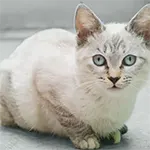Origin and History
The Burmilla cat breed emerged accidentally in the United Kingdom in 1981. This breed originated from a cross between a Chinchilla Persian and a Burmese, combining the striking features and temperaments of both parent breeds. The initial crossbreeding was an unplanned event that occurred when a male Chinchilla Persian named Jemari Sanquist mated with a lilac Burmese female named Bambino Lilac Faberge, who was left together in a breeding room by mistake. The resulting kittens were so appealing that breeders decided to establish a new breed, thus giving rise to the Burmilla.
Appearance
Burmilla cats are medium-sized with a muscular yet elegant body, reflecting their Burmese heritage. Their head is rounded with a gentle contour and a distinctive “break” between the nose and forehead, a feature inherited from their Persian ancestors. One of the breed’s most captivating features is their eyes, which are large, expressive, and outlined by a dark rim, giving them a made-up appearance. The eye color is usually green or yellow, depending on the coat color.
Their coat can be either short or semi-long, the latter being a trait from the Chinchilla Persian side. The short-haired variety has a plush, dense coat, while the semi-long-haired has a silky texture with a slight undercoat. The defining characteristic of the Burmilla’s coat is the “tipping” or “shading” effect, where the tip of each hair is colored, giving a shimmering effect to the coat. The most common colors are silver and gold, with the tipping in various shades such as black, blue, chocolate, lilac, and caramel.
Personality and Temperament
Burmilla cats are known for their playful, affectionate nature. They are gentle and sociable, often described as retaining their kitten-like playfulness well into adulthood. Burmillas are good with children and other pets, making them excellent family companions. They strike a perfect balance between being active and laid-back, enjoying playtime as much as relaxing moments beside their human companions.
These cats are known for their intelligence and curious nature, often exploring their surroundings with keen interest. Despite their playful side, they are not overly demanding of attention, making them well-suited to various living environments, including apartments. Burmillas have a soft, melodious voice and will communicate their desires and affection to their owners without being overly vocal.
Health
The Burmilla is generally a healthy breed with no specific genetic health issues directly attributed to them. However, as with any breed, they can inherit some conditions from their Burmese and Persian ancestry. Potential health concerns may include kidney issues (Polycystic Kidney Disease from the Persian side) and heart issues (Hypertrophic Cardiomyopathy from the Burmese side). Regular health check-ups, a balanced diet, and exercise can help mitigate these risks and ensure a long, healthy life for a Burmilla.
Due to the mix of Persian genetics, some long-haired Burmillas may require regular grooming to prevent matting and maintain the health and appearance of their coat. Regardless of coat length, regular grooming is recommended to remove loose hair and minimize shedding.
Overall, the Burmilla is a delightful breed, offering the best of both worlds from its ancestors—the plush coat and elegance of the Chinchilla Persian and the playful, affectionate temperament of the Burmese. They make loving, engaging pets suitable for a wide range of households.










